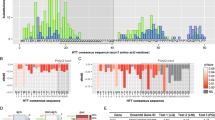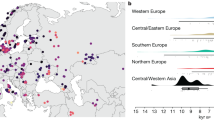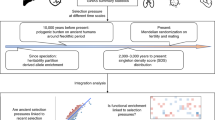Abstract
Huntington's disease (HD) correlates with abnormal expansion in a block of CAG repeats in the Huntington's disease gene. We have investigated HD evolution by typing CAG alleles in several human populations and in a variety of primates. We find that human alleles have expanded from a shorter ancestral state and exhibit unusual asymmetric length distributions. Computer simulations are used to show that the human state can be derived readily from a primate ancestor, without the need to invoke natural selection. The key element is a simple length–dependent mutational bias towards longer alleles. Our model can explain a number of empirical observations, and predicts an ever–increasing incidence of HD.
This is a preview of subscription content, access via your institution
Access options
Subscribe to this journal
Receive 12 print issues and online access
$209.00 per year
only $17.42 per issue
Buy this article
- Purchase on Springer Link
- Instant access to full article PDF
Prices may be subject to local taxes which are calculated during checkout
Similar content being viewed by others
References
The Huntington's Disease Collaborative Research Group. A Novel Gene Containing a Trinucleotide Repeat that Is Expanded and Unstable on Huntington's Disease Chromosomes. Cell 72, 971–983 (1993).
Barron, L.H. et al. A study of the Huntington's disease associated trinucleotide repeat In the Scottish population. J. med. Genet. 30, 1003–1007 (1993).
Duyao, M. et al. Trinucleotide repeat length instability and age of onset in Huntington's disease. Nature Genet. 4, 387–392 (1993).
Andrew, S.E. et al. The relationship between trinucleotide (CAG) repeat length and clinical features of Huntington's disease. Nature Genet. 4, 398–403 (1993).
Snell, R.G. et al. Relationship between trinucleotide repeat expansions and phenotypic variation in Huntington's disease. Nature Genet. 4, 393–397 (1993).
Rubinsztein, D.C., Barton, D.E., Davison, B.C.C. & Ferguson-Smith, M.A. Analysis of the huntingtin gene reveals a trinucleotide-length polymorphism In the region of the gene that contains two CCG-rich stretches and a correlation between decreased age of onset of Huntington's disease and CAG repeat number. Hum. molec. Genet. 2, 1713–1715 (1993).
Harper, P.S. The Epidemiology of Huntington's Disease. in Huntington's Disease (ed Harper, P.S.) 251–280 (Saunders Ltd, London, 1991).
Rubinsztein, D.C., Leggo, J., Barton, D.E. & Ferguson-Smith, M.A. Site of (CCG) expansion in huntingtin gene. Nature Genet. 5, 214–215 (1993).
Warner, J.P., Barron, L.B. & Brock, D.J.P. A new Polymerase Chain Reaction (PCR) assay for the trinucleotide repeat that is unstable and expanded in Huntington's Disease chromosomes. Molec. Cell Probes 7, 235–239 (1993).
Vergnaud, G. et al. The use of synthetic tandem repeats to isolate new VNTR loci: cloning of a human hypermutable sequence. Genomics 1, 135–144 (1991).
Rouse, I. in Migrations in Prehistory 67–105 (Yale University Press, New Haven, London, 1986).
Carey, N. et al. Meiotic drive at the myotonic dystrophy locus? Nature Genet. 6, 117–118 (1994).
Zuhlke, C., Reiss, O., Bockel, B., Lange, H. & Thies, U. Mitotic stability and meiotic variability of the (CAG)n repeat in the Huntington disease gene. Hum. molec. Genet. 2, 2063–2067 (1994).
Goldberg, Y.P. et al. Molecular analysis of new mutations for Huntington's disease: intermediate alleles and sex of origin effects. Nature Genet. 5, 174–179 (1993).
Myers, R.H. et al. De novo expansion of a (CAG)n repeat in sporadic Huntington's disease. Nature Genet. 5, 168–173 (1993).
Maddox, J. Triplet repeat genes raise questions. Nature 368, 685 (1994).
Mahadevan, M.S., Foitzik, M.A., Surh, L.C. & Korneluk, R.G. Characterisation and polymerase chain reaction (PCR) detection of an Alu deletion polymorphism in total linkage disequilibrium with myotonic dystrophy. Genomics 15, 446–448 (1993).
Slierendregt, B.L. et al. Major histocompatibilitycomplex class II haplotypes In a breeding colony of chimpanzees (Pan troglodytes). Tissue Antigens 42, 55–61 (1993).
Reiss, O., Noerremoelle, A., Soerensen, S.A. & Epplen, J.T. Improved PCR conditions for the stretch of (CAG)n repeats causing Huntington's disease. Hum. molec. Genet. 2, 637 (1993).
Author information
Authors and Affiliations
Rights and permissions
About this article
Cite this article
Rubinsztein, D., Amos, W., Leggo, J. et al. Mutational bias provides a model for the evolution of Huntington's disease and predicts a general increase in disease prevalence. Nat Genet 7, 525–530 (1994). https://doi.org/10.1038/ng0894-525
Received:
Accepted:
Issue Date:
DOI: https://doi.org/10.1038/ng0894-525
This article is cited by
-
The evolutionary history of the polyQ tract in huntingtin sheds light on its functional pro-neural activities
Cell Death & Differentiation (2022)
-
Antagonistic pleiotropy in mice carrying a CAG repeat expansion in the range causing Huntington’s disease
Scientific Reports (2019)
-
Fertility and apparent genetic anticipation in Lynch syndrome
Familial Cancer (2014)
-
No evidence of genetic anticipation in a large family with Lynch syndrome
Familial Cancer (2014)
-
Huntington disease in the South African population occurs on diverse and ethnically distinct genetic haplotypes
European Journal of Human Genetics (2013)



